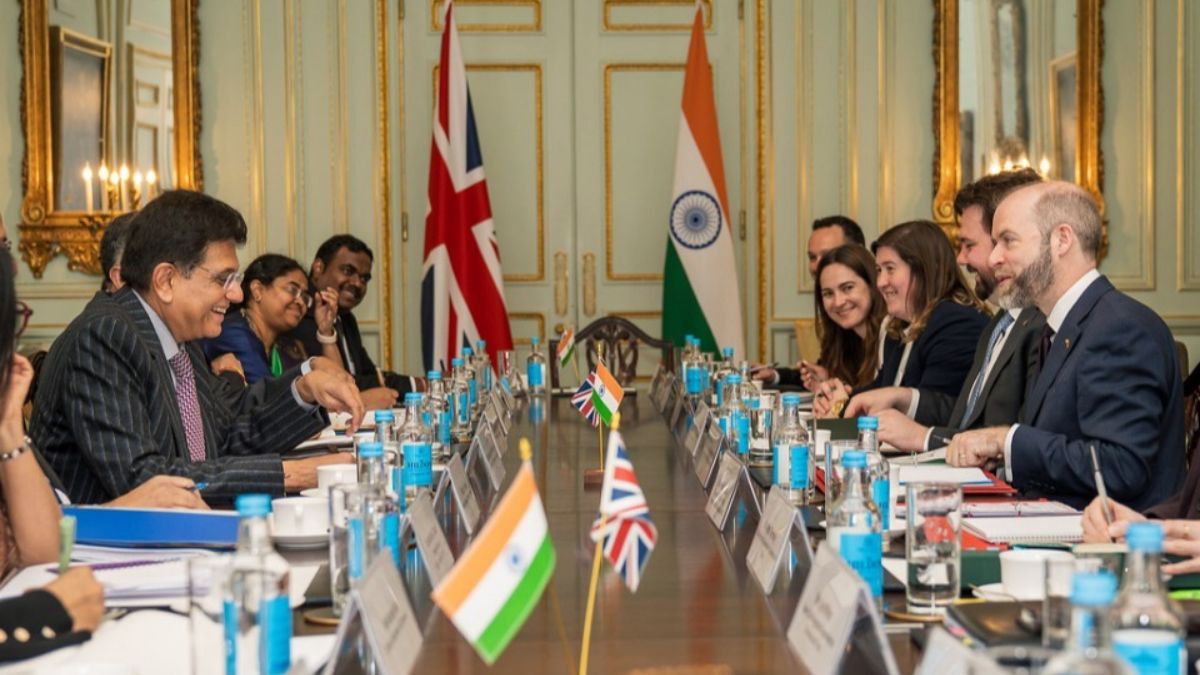India’s bumper prize from the UK FTA will be the speeding up of another, more significant pact
 Delegations from India and the UK during the FTA deal talks | X/The UK Government
Delegations from India and the UK during the FTA deal talks | X/The UK Government
While trade between the UK and India will surely get a boost with the free trade agreement (FTA) between the two countries helping both countries’ bottom lines, the bigger significance of this deal is on three related geo-economic and strategic manoeuvres.
First of all is that the successful completion of the talks and how negotiators found a way out of a couple of roadblocks that had vexed it for long, will catalyse the long-pending similar deal that India had been pursuing with the larger European Union (EU) block.
Unlike the UK talks which started about three years ago, India’s pursuit of an FTA with EU has meandered along for nearly two decades. In fact, both sides had as much as given up on it back in 2013 leading to a nine-year lull, before talks picked up again in the summer of 2022.
The next round of India-EU talks is scheduled for next week.
The UK FTA conclusion even prompted Finance Minister Nirmala Sitharaman to sound confident in Milan, Italy, where she expressed hope that the India-EU FTA will be next. Commerce minister Piyush Goyal even hinted at this when he commented ostensibly on the UK FTA completion that FTAs are not only about goods and services but also “protect core interests while opening doors to India’s greater participation in global value chains.”
Second, is the ‘elephant in the room’ for both India and the EU—Trump’s America and the chaos it has sparked off on the global trade stage with his tariff tantrums. Both the EU and India need to offset whatever Trump finally settles down on, and what’s better than finding solid enough alternative partners of your own?
As it stands, the EU is India’s biggest goods export market, while Europe does have visions of India’s massive domestic market enough of a compensation to offset whatever trade googlies Trump may throw their way.
“Most importantly, the UK FTA signals India’s openness to striking free trade agreements, and in this moment of global uncertainty, that is key,” said Rahul Ahluwalia, founder-director of Foundation for Economic Development, a Delhi-based public policy think-tank.
As per official EU figures, India is the EU’s biggest trading partner, accounting for 12.2 per cent of India’s trade, even more than the US at 10.8 per cent and China at 10.5 per cent . Of course, that is an overall trade figure, because India exports more to the US, and imports way beyond a level of comfort from China.
A trade deal, both the continental bloc and the Asian sub-continent hope, could alter this dependence on superpowers (the US for EU and China for India) into a more equitable partnership of two fairly equal (economy and trade size-wise) entities.
Third, and crucial for India, is about putting its eggs in different baskets, or in other words, reducing the dependence on a few big trading partners. Especially China with which India has long-running border disputes, and the US, which under Trump, has been flip-flopping on tariffs and policy on not just matters of trade ever since he took over.
It also perhaps realises that the days of WTO and globally regulated trade are all but over, and it doesn’t want to be caught unawares especially considering two major sore points—one, the fact that it is a net importer of costly petroleum products, and the other, its over-dependence for industrial raw materials on China.
This is also one of the reasons India has been on an FTA spree in recent years. After concluding deals with Australia, UAE and now the UK, next in line are a plethora of negotiations at various stages of negotiations. This ranges from Oman and EFTA (Iceland, Norway, Liechtenstein & Switzerland) to Chile and Peru.
Business